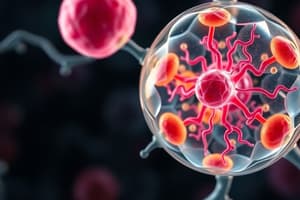Podcast
Questions and Answers
Hva er en koblet reaksjon?
Hva er en koblet reaksjon?
- En reaksjon som ikke påvirker andre reaksjoner
- En reaksjon som frigjør energi og driver en annen reaksjon som krever energi (correct)
- En reaksjon som krever energi og gir energi til en annen reaksjon
- En reaksjon der all energi frigjøres uten noen energikrav
Hva er hovedfunksjonen til adenosintrifosfat (ATP) i celler?
Hva er hovedfunksjonen til adenosintrifosfat (ATP) i celler?
- Nedbryte matmolekyler
- Lagre og transportere kjemisk energi (correct)
- Frigi energi uten krav til energi
- Bygge opp komplekse organiske molekyler
Hva kreves for produksjon av ATP fra ADP og et fosfatmolekyl?
Hva kreves for produksjon av ATP fra ADP og et fosfatmolekyl?
- Energi fra nedbrytningen av proteiner
- Energi fra nedbrytningen av glukose (correct)
- Energi fra nedbrytningen av fett
- Energi fra fotosyntesen
Hva er katabolisme i celler?
Hva er katabolisme i celler?
Hva er formålet med matmoleklenes nedbrytning i cellene?
Hva er formålet med matmoleklenes nedbrytning i cellene?
Hva er hovedfunksjonen til enzymer i nedbrytningen av glukose?
Hva er hovedfunksjonen til enzymer i nedbrytningen av glukose?
Hvor foregår oksidativ fosforylering i eukaryote celler?
Hvor foregår oksidativ fosforylering i eukaryote celler?
Hva er hovedfunksjonen til aktive bærere som ATP og NADH i cellen?
Hva er hovedfunksjonen til aktive bærere som ATP og NADH i cellen?
Hvorfor frigjøres energien fra glukose gradvis ved nedbrytning i cellen?
Hvorfor frigjøres energien fra glukose gradvis ved nedbrytning i cellen?
Hvilken type sukker bruker cellene som energikilde for nedbrytning?
Hvilken type sukker bruker cellene som energikilde for nedbrytning?
Hvor brukes energien fra aktive bærere for å drive syntesen av ATP?
Hvor brukes energien fra aktive bærere for å drive syntesen av ATP?
Flashcards are hidden until you start studying
Study Notes
Cell Respiration
- Cell respiration is the process of breaking down sugar to produce energy.
ATP Production
- There are two ways to produce ATP:
- Directly through enzymatic reactions that break down molecules from food, which are energy-favorable reactions that produce ATP and active carriers.
- Through oxidative phosphorylation, which takes place in the mitochondrial membrane of eukaryotic cells or in the plasma membrane of aerobic prokaryotes, using energy from active carriers to drive ATP synthesis.
Cellular Respiration
- In living cells, glucose (a type of sugar used as an energy source) is broken down in several stages with the help of enzymes, which catalyze chemical reactions without being consumed in the process.
- The breakdown of glucose releases energy, but instead of releasing it all at once (which would be inefficient and potentially harmful), the energy is released gradually through a series of chemical reactions.
- In these reactions, the energy released from glucose is transferred to "active carriers" (often ATP and NADH), which can temporarily store and transport energy within the cell.
Active Carriers
- Active carriers are molecules that can temporarily store and transport energy within the cell, such as adenosine triphosphate (ATP).
- ATP is produced when energy from glucose breakdown is transferred to adenosine diphosphate (ADP) and a phosphate molecule (Pi), a process that requires energy.
- This energy comes from the energy-favorable reactions in glucose breakdown, making it possible to produce ATP.
Katabolism
- Katabolism is the breakdown process where enzymes break down complex organic molecules into simpler molecules.
- This process occurs in three stages, involving the breakdown of protein, fat, and polysaccharides, which make up most of the food we eat.
Studying That Suits You
Use AI to generate personalized quizzes and flashcards to suit your learning preferences.





